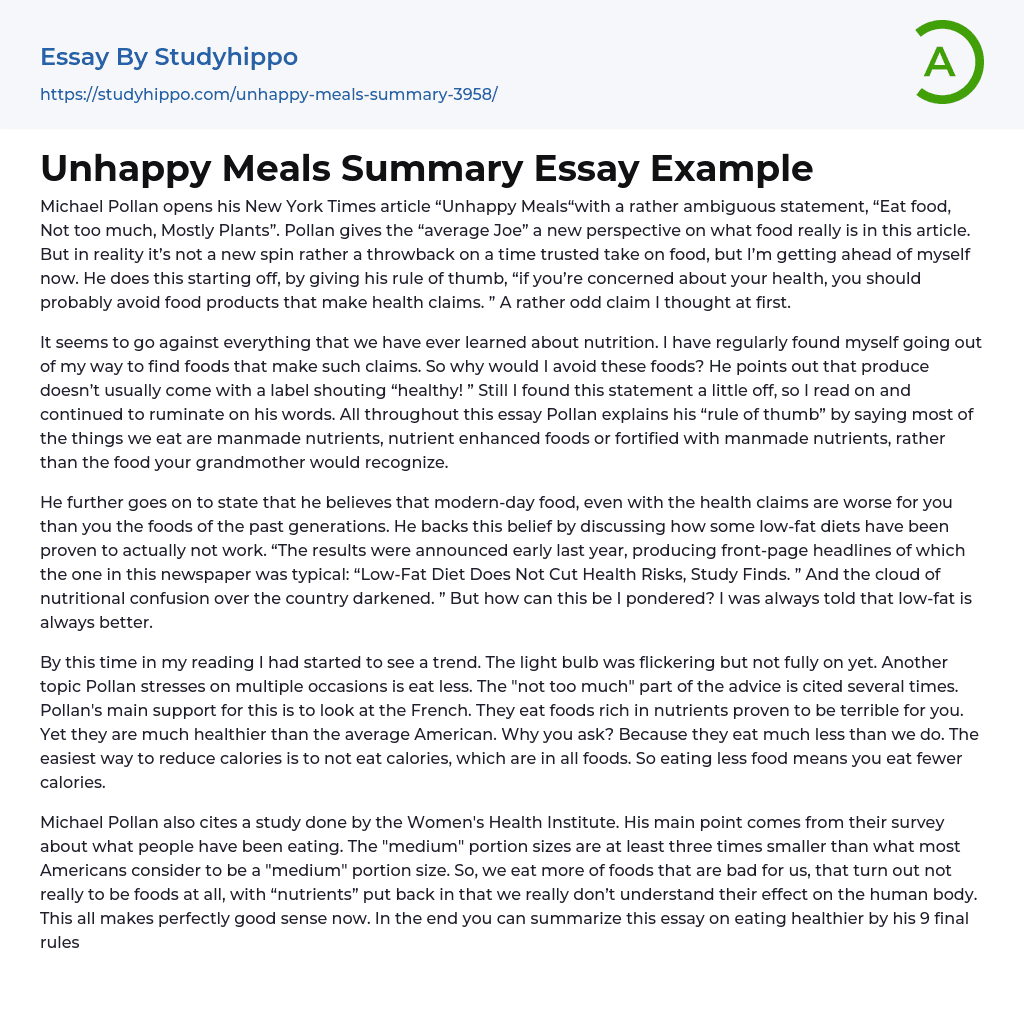Michael Pollan opens his New York Times article “Unhappy Meals“with a rather ambiguous statement, “Eat food, Not too much, Mostly Plants”. Pollan gives the “average Joe” a new perspective on what food really is in this article. But in reality it’s not a new spin rather a throwback on a time trusted take on food, but I’m getting ahead of myself now. He does this starting off, by giving his rule of thumb, “if you’re concerned about your health, you should probably avoid food products that make health claims. ” A rather odd claim I thought at first.
It seems to go against everything that we have ever learned about nutrition. I have regularly found myself going out of my way to find foods that make such claims. So why would I avoid these foods? He points out that produce doesn’
...t usually come with a label shouting “healthy! ” Still I found this statement a little off, so I read on and continued to ruminate on his words. All throughout this essay Pollan explains his “rule of thumb” by saying most of the things we eat are manmade nutrients, nutrient enhanced foods or fortified with manmade nutrients, rather than the food your grandmother would recognize.
He further goes on to state that he believes that modern-day food, even with the health claims are worse for you than you the foods of the past generations. He backs this belief by discussing how some low-fat diets have been proven to actually not work. “The results were announced early last year, producing front-page headlines of which the one in this newspaper was typical: “Low-Fat Diet Does Not Cut Health Risks
Study Finds. ” And the cloud of nutritional confusion over the country darkened. ” But how can this be I pondered? I was always told that low-fat is always better.
By this time in my reading I had started to see a trend. The light bulb was flickering but not fully on yet. Another topic Pollan stresses on multiple occasions is eat less. The "not too much" part of the advice is cited several times. Pollan's main support for this is to look at the French. They eat foods rich in nutrients proven to be terrible for you. Yet they are much healthier than the average American. Why you ask? Because they eat much less than we do. The easiest way to reduce calories is to not eat calories, which are in all foods. So eating less food means you eat fewer calories.
Michael Pollan also cites a study done by the Women's Health Institute. His main point comes from their survey about what people have been eating. The "medium" portion sizes are at least three times smaller than what most Americans consider to be a "medium" portion size. So, we eat more of foods that are bad for us, that turn out not really to be foods at all, with “nutrients” put back in that we really don’t understand their effect on the human body. This all makes perfectly good sense now. In the end you can summarize this essay on eating healthier by his 9 final rules.
- 1. Eat food “the real stuff”
- 2.Avoid food that has health claims,
- 3. Avoid food that have unfamiliar ingredients,
- 4. Stay away from the super market,
- 5. Pay
more for your healthy food then eat less of it,
After reading this article by Pollan, I have been moved on a personal level to become a more conscious and healthy eater. Most of his advice is simple and easy to follow I guess we will know if he was right or not by gauging our health against our next generation’s health. References Pollan, Michael. "Unhappy Meals. " The New York Times 28 Jan. 2007. Print.
- Food Safety essays
- Food Security essays
- Beverages essays
- Cuisines essays
- Dairy essays
- Desserts essays
- Fast Food essays
- Bread essays
- Meal essays
- Meat essays
- Organic Food essays
- Rice essays
- Sugar essays
- Taste essays
- Beef essays
- Coconut essays
- Crowd essays
- Dinner essays
- Juice essays
- Sainsbury essays
- Cooking essays
- Ginger essays
- Oreo essays
- Drink essays
- Beer essays
- Wine essays
- Coffee essays
- Tea essays
- Cake essays
- Hamburger essays
- Ice Cream essays
- Burger essays
- Pizza essays
- Fruit essays
- Lemon essays
- Food Waste essays
- Favorite Food essays
- Alcoholic essays
- Soft Drinks essays
- Cookie essays
- Starch essays
- Yeast essays
- Cola essays
- Pizza Hut essays
- snack foods essays
- chips essays
- Biscuit essays
- Brewing essays
- Brewery essays
- American Literature essays




